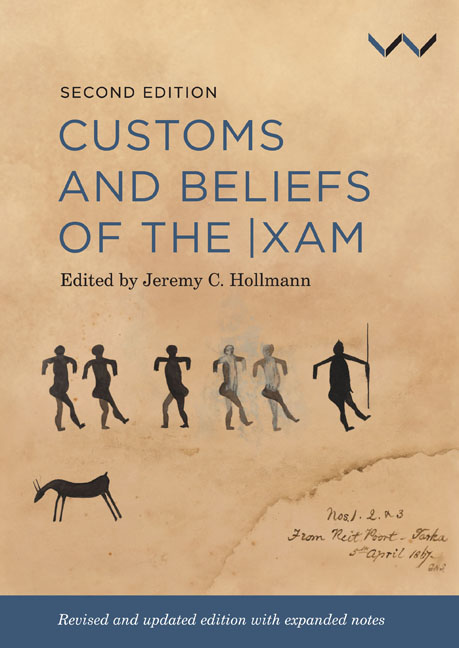Book contents
- Frontmatter
- Dedication
- Contents
- Acknowledgements
- Foreword To The Second Edition
- Foreword To The First Edition
- Introduction
- Contributors
- The |Xam Language
- The People In The Notebooks
- Part 1 Baboons
- Part 2 The Lion
- Part 3 Game Animals
- Part 4 Omens, Windmaking, Clouds
- Part 5 Rain
- Part 6 Rainmaking
- Part 7 Sorcerers
- Part 8 More About Sorcerers and Charms
- Part 9 Special Speech of Animals and Moon
- Appendix 1 |Xam Grammar
- Appendix 2 Summary of The Narratives
- References
- Index
Introduction
Published online by Cambridge University Press: 24 November 2023
- Frontmatter
- Dedication
- Contents
- Acknowledgements
- Foreword To The Second Edition
- Foreword To The First Edition
- Introduction
- Contributors
- The |Xam Language
- The People In The Notebooks
- Part 1 Baboons
- Part 2 The Lion
- Part 3 Game Animals
- Part 4 Omens, Windmaking, Clouds
- Part 5 Rain
- Part 6 Rainmaking
- Part 7 Sorcerers
- Part 8 More About Sorcerers and Charms
- Part 9 Special Speech of Animals and Moon
- Appendix 1 |Xam Grammar
- Appendix 2 Summary of The Narratives
- References
- Index
Summary
About 150 years ago a well-known but nonetheless extraordinary chain of events brought together two diverse groups of people in colonial-era Cape Town, South Africa. Their life circumstances could hardly have been more different. On the one hand there were the |xɑm people, some related by birth and marriage, who were serving or had finished serving terms of imprisonment at the Breakwater Prison. On the other hand was a middle-class European family living in relative comfort in the village of Mowbray (now a Cape Town suburb). The Bleek and Lloyd Collection (BLC) is the product of the interaction between these two groups.
The |xɑm prisoners had been captured and imprisoned for crimes of resistance committed in |xɑm-kɑ ǃɑũ, ‘the |xɑm's land’, against Dutch-speaking pastoralists who had first taken control of water sources and after that, the land itself (ironically now called Bushmanland). Their presence eventually forced the |xɑm, the country's long-time inhabitants, into the colonial economy, as servants of the pastoralists as well as poachers of their livestock (see Penn [2005] for a detailed account of this brutal invasion and bitter transformation).
With their land and liberty lost, the |xɑm nonetheless had three valuable assets remaining to them: their bodies, their language and their ‘stories’ or kukummi (a word with context-specific meanings, such as ‘story, talk, history, news’, Bleek 1956: 106). These were things in which Wilhelm Bleek – a Prussian philologist with ambitions to develop his theories about the evolution of language – had a keen interest.
Initially, Wilhelm Bleek visited and interviewed prospective |xɑm narrators at the Breakwater Prison but soon asked for (and received) permission for their transfer to his residence, ‘The Hill’, in Mowbray. The first of these was the young man |ɑǃkuŋtɑ in late August 1870, followed by ‖kɑbbo early in 1871. It was during this period that Bleek carried out the so-called scientific photography and measurement of some of the |xɑm prisoners at the behest of the Cape governor, Sir Henry Barkly, on behalf of Thomas Huxley, the British anthropologist (Bank 2006: chapter 4).
The work of recording and transcribing the |xɑm narrators’ words was carried out between 1870 and 1879 and created a corpus of thousands of pages. In this book, I use the word ‘narrative’ to describe this spoken testimony – the telling, recounting and relating – of stories, sketches, incidents, thoughts and so on.
- Type
- Chapter
- Information
- Customs and Beliefs of the |xam , pp. 1 - 12Publisher: Wits University PressPrint publication year: 2022



